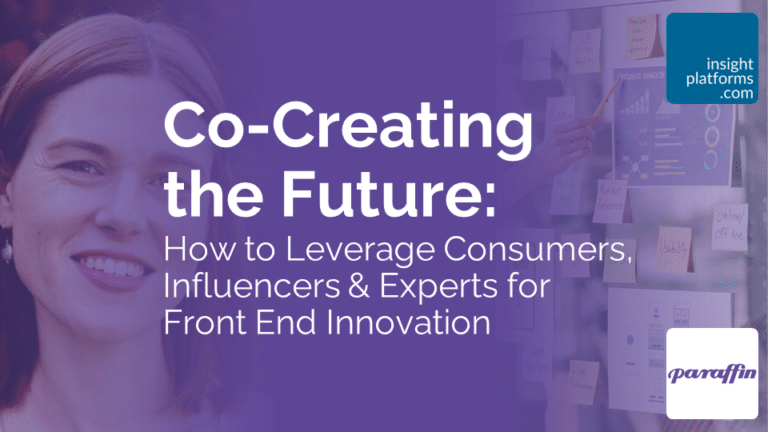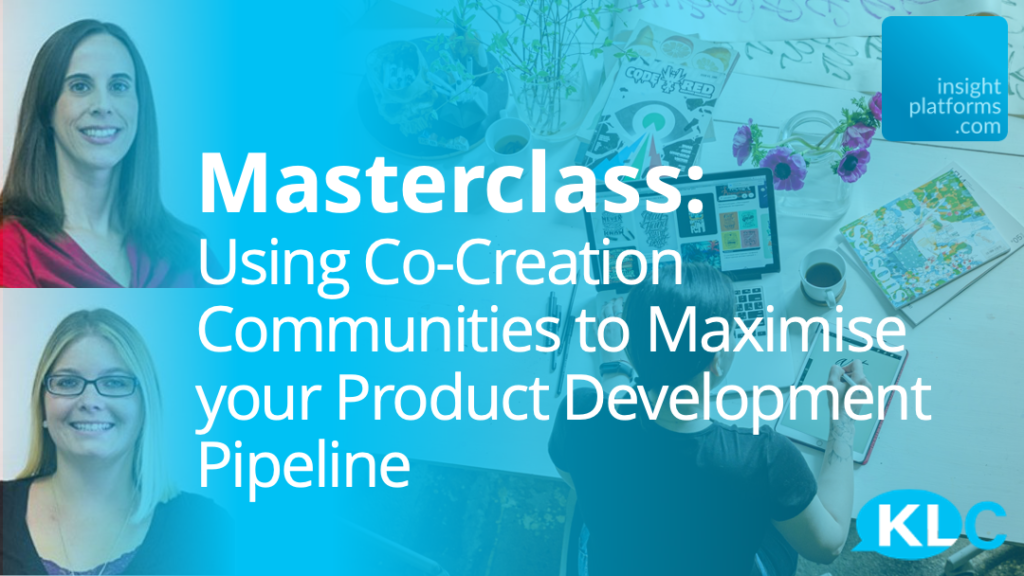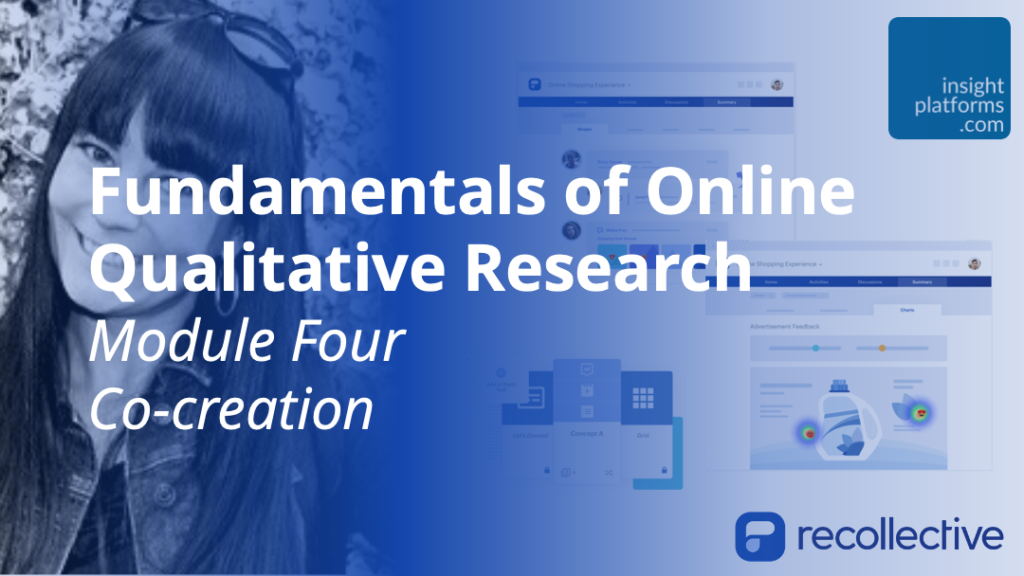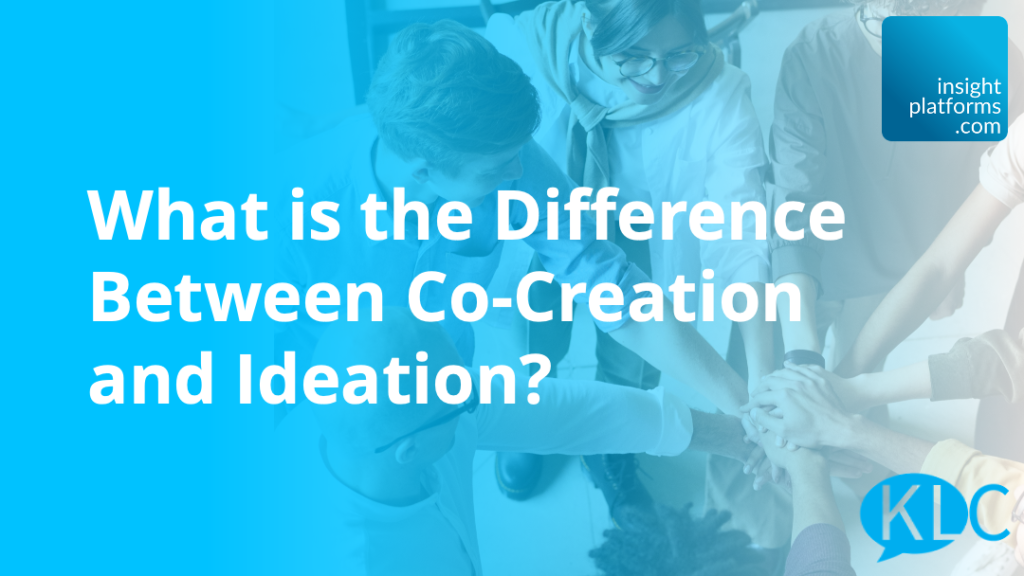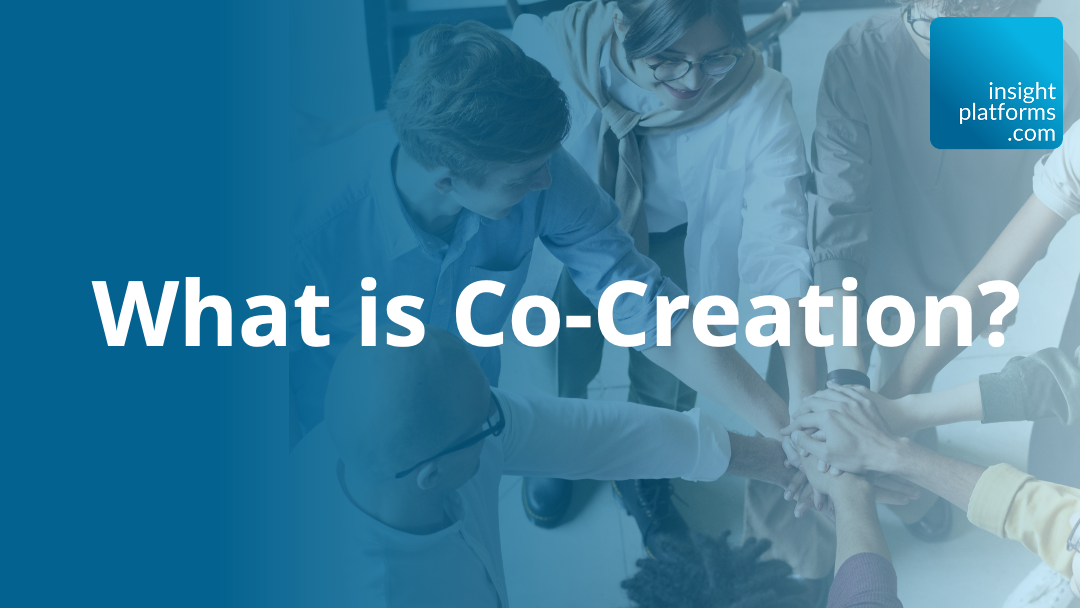
What is Co-Creation?
By Insight Platforms
- article
- explainer
- Co-creation
- Insight Communities
- Online Communities
- Ideation
- Product Development Research
- Creative Testing
- Online Collaboration
- Online Workshops
Co-Creation: Let the Bright Ones In
Opening up: the early days
It doesn’t matter where you work: there will always be more smart people outside your organisation than inside it.
In the second half of the 20th Century – as market research evolved from an activity to an industry – we built tools to learn what some of these smart people wanted: surveys, depth interviews, observations, focus groups and panels.
But these methods kept the smart people at arm’s length and othered them as consumers, customers or suppliers. That left a big gap between their input and the reality of developing new ideas.
So in the 90s, a new philosophy of collaboration began to emerge: bring smart people inside your organisation so they can co-create products, services or campaigns with you.
Ideas should stand a better chance of getting through later stages in the innovation funnel if they were developed with this foot-in-both-camps perspective.
New types of agencies like IDEO and ?What If! Innovation pioneered methods to bring outside people in – and, conversely – to immerse the inside people in the reality of the outside experience.
Select groups of customers might be given factory tours, participate in idea generation workshops and then be consulted repeatedly as projects developed.
Managers might take part in consumer safaris of their category or mystery shop their own services to build empathy before a collaborative workshop.
These approaches were the fore-runners of frameworks that are now widespread: Human-Centred Design, User Experience Research and Open Innovation.
Collaboration goes digital
Then, from the early 2000s, organisations began doing many of these things in the digital realm.
One of the earliest uses of the co-creation term was in a Harvard Business Review article which explained the benefits of closer relationships with customers.
“Thanks largely to the Internet, consumers have been increasingly engaging themselves in an active and explicit dialogue with manufacturers of products and services.”
Co-opting Customer Competence (hbr.org), Feb 2000 edition
At first, the experience was clunky and a poor substitute for IRL. But smartphones, fast data and new behavioural norms from social media changed all that.
Now, online co-creation is practical and affordable for many types of organisation: big enterprise teams, tiny startups, businesses, government departments and non-profit bodies.
It allows more people in more places to feed into the innovation process; it is helping to launch products people actually want; and it often helps them get to market faster.
Co-Creation vs Crowdsourcing vs Open Innovation
Before digging deeper, it’s worth clarifying some of these terms. Co-Creation is often used interchangeably with Open Innovation and Crowdsourcing. In broad terms, these are all about encouraging smart ideas into the organisation from the outside.
Open Innovation is an umbrella term that covers many different methods and tools. Co-Creation and Crowdsourcing sit within the Open Innovation framework.
But these two approaches often get confused – so be careful. In simple terms, Crowdsourcing involves getting input on a specific topic from lots of individuals. This can be high risk if not managed carefully (see Boaty McBoatFace, Death Flavoured Crisps and disgusting product suggestions for Mountain Dew).
Co-Creation involves much deeper engagement, more collaboration between participants and usually iteration over a period of time.
It’s confusing because many open innovation programmes actually involve both approaches: witness the LEGO IDEAS platform, which invites fans to create and upload their designs for new LEGO play sets (Crowdsourcing).
Each of the designs is posted on the IDEAS website and both LEGO fans and the wider public can vote for their favourite project.
When a project gets over 10,000 votes, LEGO works with the creator to refine design and marketing plans (Co-Creation).
Once it goes into production, the creator receives a royalty of 1% of the net sales.

Here’s a handy comparison chart from KLC that highlights the key differences between Co-Creation and Crowdsourcing approaches:
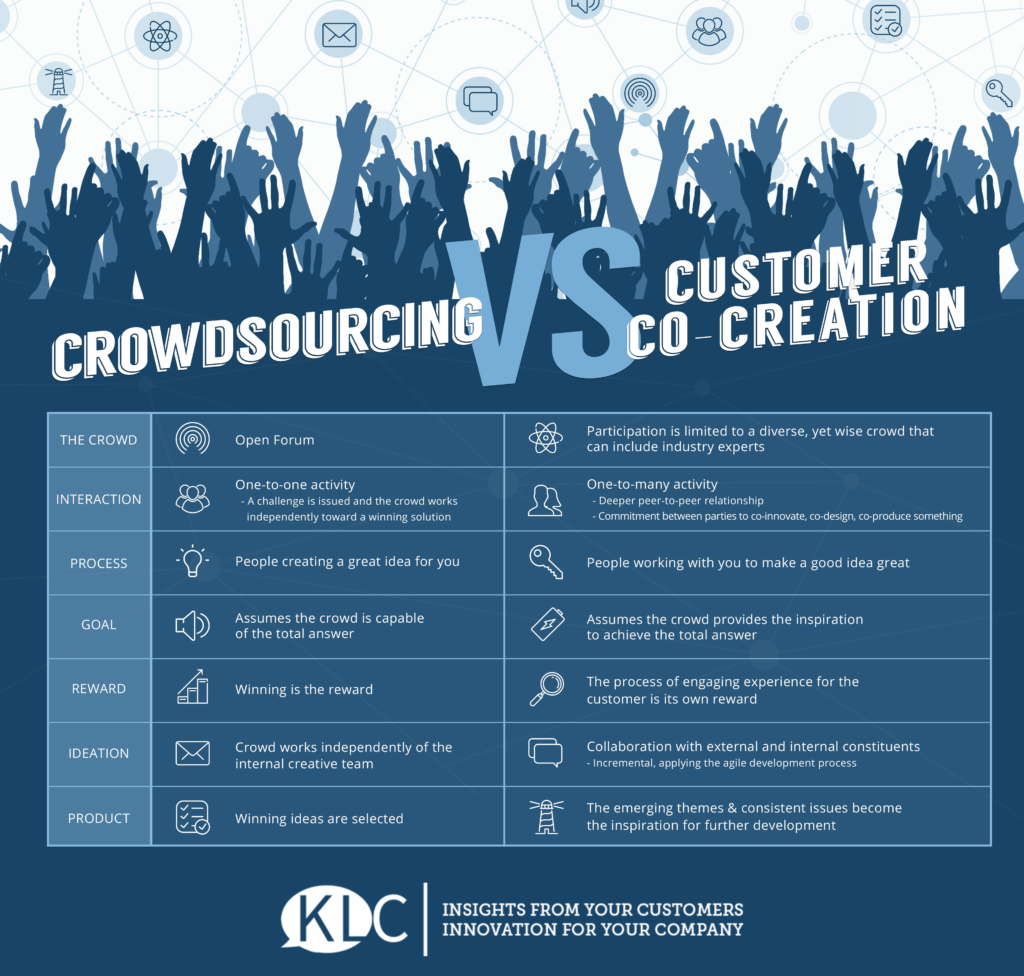
You can read the full KLC article here; you can also find out more about this from Chaordix and Wazoku.
Key Features of Co-Creation
It sounds easy. Get a bunch of managers and customers together. Give them a challenge. Harvest the inspiration and make lots of money.
OK, good luck with that.
Here’s what you actually need for successful co-creation projects.
1. Collaboration
This is the ‘Co’ part: bringing people together to work on an idea. ‘Together’ has been redefined over the last year or two, with digital environments now rivalling face-to-face for effectiveness.
The innovation experts from Paraffin even regard online workshops as superior to their IRL counterparts in many ways; here’s a quick comparison of some tech options to run your co-creation session.
Tools like Mural and Miro are great for visual thinking exercises.
Online community and qualitative research platforms have great features for brainstorming, collaborative design exploratory research and even concept prioritisation.
Specialist video-based research platforms can also play a role; or you can go generic with webinar and meeting tools like Zoom or Microsoft Teams.
But collaboration is about far more than technology. Good facilitation is critical. Plan, plan and plan again. Give participants equal status and encourage involvement from the quiet ones. Manage the time effectively.
In fact, this topic is so huge, someone should write a book about it.
2. Creativity
If you want to (co) create, you’ll need creativity.
And there’s a formula for this:
PPP > SS
Planning, preparation and pre-work beat sparks and spontaneity every time.
Most co-creation sessions or projects start with the ‘no bad ideas’ rule … but that’s only the first half of the first diamond.
There are many techniques for priming the creative pump: experiential, sensorial, storytelling, performance, deprivation exercises … again, there are more books and courses and workshops on this than can be listed here.
But if you take one thing away from this, it’s to remember that you have to work hard and create the conditions for creativity; it doesn’t come by itself.
3. Diversity
“The single most important difference to [workshop] success is the kind of people you invite, not just how many. The people participating will make all the difference to its success. Research has found that a greater diversity in gender, background and ethnicity leads to higher collective intelligence (when combined with the right creative behaviours).”
Pam Hamilton, The Workshop Book
If you want to read the evidence, the sources are linked in Pam’s book.
Or you can learn more in these masterclass sessions:
4. Selection
You really need to shut down your bad idea bears once you’ve listened to them for a while.
Selecting the most promising candidate ideas is essential for moving things forward. Create clusters or themes; synthesise similar ideas into a new one; allow participants to vote; align the group on what goes forward to the next phase.
5. Iteration
Co-creation is not a single brainstorm, workshop or project. It’s an on-going process of refinement and enhancement. Ideas need to be nurtured.
In-person sessions may run over several days or even mimic the 5-day Sprint format beloved by the tech industry. Graphic artists may mock up concepts overnight; designers may even create prototypes to feed back into the same group of participants.
In this workshop, we even live-tested crude concepts with hundreds of consumers online using the Attest platform – which gave us enough data (500 completes) after just an hour. enough to pick the winner.
And of course, online communities are a great way to keep co-creating over a longer time frame.
The Benefits of Co-Creation
Co-Creation is an exploratory and generative process. Here are some of the main reasons you should consider it.
1. Fewer terrible products
OK, you got me. The first benefit should be expressed in more positive terms. Lower risk innovation. Better product / market fit. More relevant ideas.
All true, and all contenders.
But when 19 out of 20 innovations fail – according to Harvard Business School professor Clayton Christensen – we should be celebrating anything that reduces the volume of crap that companies make.
Co-creation increases innovation success rates because – if done properly – customers take part in the process. They keep the early ideas grounded in their reality. And they help weed out nonsense before it takes root.
2. Inspiration through diversity
Co-Creation works best when it brings together diverse perspectives, as the evidence from the Workshop Book shows.
A project for a food manufacturer, for example, may involve consumers from different segments, categories or geographies; buyers from retail channel partners; amateur cooks or professional chefs; experts from ingredient manufacturers; and internal team members from brand, R&D or trade marketing teams.
Even projects that only include customers can lead to genuinely creative ideas if people with different views and backgrounds participate actively. The key is to ensure they are well profiled, properly recruited and clearly briefed – and that good facilitation allows these different views are all heard.
When managed well with the right mix of people, this diversity is where the Co-Creation magic really happens.
3. Shorter development cycles
Co-Creation – especially when done online – can bring dispersed groups of participants together quickly or at short notice.
In some ways, Co-Creation projects can feel a bit like agile sprints: cross-functional input, different activities happening in parallel and lots of rapid iteration.
You also get plenty of indecipherable sketches; lots of opinions; and sessions can even feel a little frantic. But the energy and momentum usually translate into far quicker progress than traditional innovation approaches.
4. Active stakeholder engagement
Of those 19 in 20 product failures, HIPPOs – the Highest Paid Person’s Opinion – are responsible for 12.
Actually, I made that up. But it sounds plausible. You see how HIPPOs operate now?
Big men with big sounding job titles make gut-feel assertions that waste fortunes on bad product ideas.
(And yes – sorry guys – men are far more likely to do this … women in similar roles tend to seek more evidence and expert guidance before punting millions into pet projects).
Co-Creation puts stakeholders together with customers as part of a managed process: one in which all participants can make valid contributions. When managers – even big-ego senior executives – go through a well-run Co-Creation project, they can feel more engaged, more invested in the customer perspective and more likely to push ideas developed collectively by the group.
5. Improved loyalty and advocacy
Getting some of your most enthusiastic, creative and vocal customers involved in building new ideas can have positive second order effects.
Those customers are more likely to remain brand loyal and even increase their spend levels. If the ideas they worked on come to market, they are likely to tell plenty of other people. They can even be incentivised as micro-influencers with their own discount codes or affiliate revenue.
Think about it: you’ve managed to get 10,000 public votes and LEGO has built your product idea. Are you going to keep quiet about that? Or shout it from the rooftops to get your 1%?
–
Note that some of these benefits dial up or down according to how the Co-Creation project is done – online or face-to-face.
Digital platforms offer greater speed, more flexibility, easier logistics, more iteration cycles and better international reach. For many of us, this has been the only option in the COVID era.
Face-to-face Co-Creation also has its place. It’s more appropriate for certain tasks and audiences; can include immersive elements (developing food ideas in a restaurant kitchen, say); and can do rapid prototyping more easily (like on-the-fly 3D printed mockups).
But – whether online or face-to-face – the key determinants of Co-Creation success are clear objectives; good session design and facilitation; and well recruited, diverse participants.
Find Out More About Co-Creation
You can find plenty more articles, webinars, masterclasses, platforms and service providers elsewhere on the site.
Here are some of the most useful:

